====================
A sermon offered by the Rev. Dr. C. Eric Funston on the Third Sunday of Easter, April 10, 2016, to the people of St. Paul’s Episcopal Church, Medina, Ohio, where Fr. Funston is rector.
(The lessons for the day are Acts 9:1-20, Psalm 30, Revelation 5:11-14, and St. John 21:1-19. These lessons may be found at The Lectionary Page.)
====================
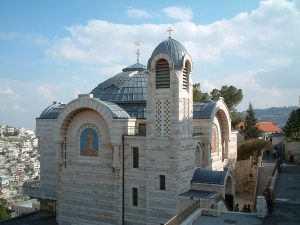 In Jerusalem, just outside the walled Old City to the south is a church built on the place where the house of Caiaphas, the high priest who oversaw Jesus’ crucifixion, is believed to have been. The church is named St. Peter in Gallicantu; the name is from the Latin meaning, “St. Peter where the rooster crowed.” It is a reference, of course, to Peter’s three denials of Christ in the courtyard of the high priest’s house.
In Jerusalem, just outside the walled Old City to the south is a church built on the place where the house of Caiaphas, the high priest who oversaw Jesus’ crucifixion, is believed to have been. The church is named St. Peter in Gallicantu; the name is from the Latin meaning, “St. Peter where the rooster crowed.” It is a reference, of course, to Peter’s three denials of Christ in the courtyard of the high priest’s house.
In the interior of the church, in niches on either side of the altar, are two icons. One depicts that episode which gives the church its name; the other, the story which we heard in today’s gospel lesson. The icons are similar in that they both depict Peter and Jesus on either side of a charcoal fire.
In the first, the fire is quite small and several other people are gathered around it. Jesus and Peter are in the foreground. Jesus is bound and looking directly at Peter; Peter’s eyes, on the other hand, are downcast and he is holding up one hand, palm toward Jesus as if to fend him off. The icon is captioned in Latin “Non novi illum” (Lk 22:57) – “I do not know him.”
In the second, the fire is much larger and is accompanied by baskets of fish and bread. There are no other people around the fire; the other disciples are still in the boat some distance off shore. Jesus, again, is looking directly at Peter. Peter, in this picture, is looking directly at Jesus and holding his hand out to Jesus to receive a shepherd’s staff which Jesus is handing to him. This icon is also captioned, again in Latin, “Domine tu omnia scis tu scis quia amo te” (Jn 21:17) – “Lord, you know everything; you know that I love you.”
Some bible scholars believe that Chapter 21 of John’s Gospel is an add-on, that the original text of this gospel ended with the statement at the end of Chapter 20: “Now Jesus did many other signs in the presence of his disciples, which are not written in this book. But these are written so that you may come to believe that Jesus is the Messiah, the Son of God, and that through believing you may have life in his name.” (vv 30-31) These scholars argue, and I think we have to admit, that that sounds pretty much like a definitive conclusion to the book. Thus, they argue that Chapter 21 from which we have heard today is either an afterthought that John felt compelled to add or the work of a second author, a false John who was apparently unsatisfied with the original text. However, I would suggest that Chapter 21 is neither an afterthought of John’s nor the forged addition of another: it is connected to the main body of John’s gospel by those charcoal fires and the number three.
![]() On that awful night, as all was being lost and his rabbi was being tried, mocked, and ultimately killed, Peter stood at that first charcoal fire and denied Jesus three times. As John tells the story in Chapter 18, Judas led the authorities to Jesus in the Garden of Gethsemane. Jesus was then taken away to Caiaphas’s courtyard and Peter, who had sworn that he would never deny Jesus, followed. The maid who watched the gate to the courtyard saw Peter and said to him, “Aren’t you one of this man’s disciples?”
On that awful night, as all was being lost and his rabbi was being tried, mocked, and ultimately killed, Peter stood at that first charcoal fire and denied Jesus three times. As John tells the story in Chapter 18, Judas led the authorities to Jesus in the Garden of Gethsemane. Jesus was then taken away to Caiaphas’s courtyard and Peter, who had sworn that he would never deny Jesus, followed. The maid who watched the gate to the courtyard saw Peter and said to him, “Aren’t you one of this man’s disciples?”
Peter replied, “No, I’m not.”
John then tells us, “Now the slaves and the police had made a charcoal fire because it was cold, and they were standing around it and warming themselves. Peter also was standing with them and warming himself.” (Jn 18:18) There and here in today’s story in Chapter 21 are the only two places in all of the New Testament that fires are specifically described as being a “charcoal fire.” John is very deliberately contrasting these two scenes in his gospel.
A bit later, those with whom Peter was standing and keeping warm by the fire asked him if he were one of Jesus’ disciples; he replied, “No, I am not.” (Jn 18:25) And immediately another person asked Peter the same question and again Peter replied, “No.”
Just then, while Peter was still standing next to the charcoal fire in the courtyard, is when the crowed, confirming Jesus’ earlier word to Peter that Peter would deny him three times before the rooster’s call. Luke’s account tells us that at that moment, “the Lord turned and looked at Peter.” (Lk 22:61) That was when Peter realized what he had done and he was devastated: this is the moment depicted in the first icon in the Church of St. Peter in Gallicantu.
Peter left that first charcoal fire a broken man, weeping bitterly, and all alone. Eventually, he would re-connect with his fellow disciples. Eventually, with them, he would witness the empty tomb and encounter the Resurrected Jesus. Eventually, with Thomas, Nathaniel, James, John, and two others John does not name, he would go fishing. Eventually, he would come to this beach and to the second charcoal fire.
![]() Looking at Peter across this charcoal fire after their breakfast of grilled fish, Jesus would begin a conversation of three questions and three answers: “Simon, son of John, do you love me more than these?” (Jn 21:15)
Looking at Peter across this charcoal fire after their breakfast of grilled fish, Jesus would begin a conversation of three questions and three answers: “Simon, son of John, do you love me more than these?” (Jn 21:15)
What Jesus is asking is if Peter loves Jesus more than the other disciples love Jesus. That is, after all, what Peter had said at dinner that night when he said that even if the others deserted Jesus he would never do that. But that, of course, is exactly what he did and more; he denied even knowing Jesus. So it must have been difficult for Peter to have this conversation at this charcoal fire remembering what happened at that charcoal fire.
Nonetheless, he answered, “Yes, Lord, you know that I love you.” In words that can only be taken as a clear sign of forgiveness as much as they are of empowerment and commissioning, Jesus responded, “Feed my lambs.” But that doesn’t end the conversation!
Jesus asked Peter a second time, “Simon son of John, do you love me?” Peter must have wondered, and certainly we wonder, why Jesus would ask him the same question. Again, he answered, “Yes, Lord; you know that I love you,” and again Jesus commissioned him, “Tend my sheep.”
And then, yet again, Jesus asked, “Simon son of John, do you love me?” (John changes the Greek verb here from agápe used in the first two questions to philía, naming in some circumstances a different sort of love, but whether that has any theological significance is a matter of debate. For us, today, it does not, but we should be aware of that change.)
John tells us that this third time, the question stings Peter. Says John, “Peter felt hurt . . . and he said to him, ‘Lord, you know everything; you know that I love you.'” (v 17) And again, Jesus commissioned Peter, “Feed my sheep” but this time with a warning saying, in essence, “It will be dangerous and you will suffer at the hands of others.”
Jesus then ended the conversation with a simple, “Follow me,” an invitation ripe with forgiveness; whatever had happened at that first charcoal fire, it is put behind them; it does not matter. The three denials have been wiped away by three declarations of love and three commissions to service. All that matters now is that Peter follow his Master and live out the task he has been given.
The second icon illustrates this as Jesus passes the pastoral staff, the shepherd’s crook, to Peter who reaches out to receive it.
In Section IV of T.S. Elliot’s poem Little Gidding the poet writes that we will all be “consumed by either fire or fire:”
The dove descending breaks the air
With flame of incandescent terror
Of which the tongues declare
The one dischage from sin and error.
The only hope, or else despair
Lies in the choice of pyre or pyre –
To be redeemed from fire by fire.Who then devised the torment? Love.
Love is the unfamiliar Name
Behind the hands that wove
The intolerable shirt of flame
Which human power cannot remove.
We only live, only suspire
Consumed by either fire or fire.
The two charcoal fires of John’s Gospel, the two charcoal fires in the Gallicantu icons, show us the two fires of Elliot’s poem: the destructive fire of denial, or the life-giving, nourishing fire of resurrection, reconciliation, and forgiveness. The genius of the Church of St. Peter in Gallicantu is that it is in the space between these fires, between the two icons, between these two stories in John’s Gospel that the people’s worship takes place, that our lives as the people of God are lived, wearing that “intolerable shirt of flame which human power cannot remove.”
What that placement of worship between those two icons says is that Peter represents all of us, that in a sense we are all Peters. All of us have committed ourselves, like Simon Peter, to follow Jesus. That commitment was made at our baptism and again at our confirmation; it has been reaffirmed again and again, as it was on Easter morning in the reaffirmation of the baptismal covenant, as it was last week when we joined in baptizing Anthony Jon and Laura May on whose behalf the promises of that covenant were made for the first time. But, just like Peter, we have all of us betrayed that covenant, broken those promises, and denied the Lord we have sworn to follow. But then comes that gentle but supreme act of absolution, uttered from the cross: “Forgive them, Father, they don’t know what they are doing.” (Lk 23:34)
The image of the charcoal fires in the Gospel of John becomes an image of that divine mercy. One moment we’re warming ourselves at the fire of denial, potentially destroyed by the poor decisions we make, decisions that break our covenant promises. The next moment we’re with Jesus as he feeds us at the fire of mercy and forgiveness. The Lord is faithful to us even when we have not been faithful to him, and it is through his faith that we are healed and restored, and eventually, like him and with him, risen to new life.
Thanks be to God. Amen.
====================
A request to my readers: I’m trying to build the readership of this blog and I’d very much appreciate your help in doing so. If you find something here that is of value, please share it with others. If you are on Facebook, “like” the posts on your page so others can see them. If you are following me on Twitter, please “retweet” the notices of these meditations. If you have a blog of your own, please include mine in your links (a favor I will gladly reciprocate). Many thanks!
====================
Father Funston is the rector of St. Paul’s Episcopal Church, Medina, Ohio.
 Every year on the Second Sunday of the Easter season, we read the story from John’s Gospel of Thomas’s refusal to accept the testimony of his fellow disciples, but in each year of the Lectionary Cycle, it is coupled with different lessons from the Book of Acts and a different epistle lesson. So this year, in Year C of the cycle, we have heard of the confrontation between Peter and the high priest about the apostles’ teaching in the Temple, and we have heard part of the introduction of John of Patmos’ Revelation.
Every year on the Second Sunday of the Easter season, we read the story from John’s Gospel of Thomas’s refusal to accept the testimony of his fellow disciples, but in each year of the Lectionary Cycle, it is coupled with different lessons from the Book of Acts and a different epistle lesson. So this year, in Year C of the cycle, we have heard of the confrontation between Peter and the high priest about the apostles’ teaching in the Temple, and we have heard part of the introduction of John of Patmos’ Revelation. 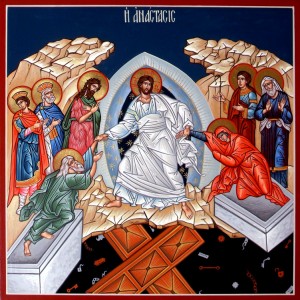 Litigation attorneys and fishermen have something in common… We like to tell stories. Fishermen tell about “the one that got away.” Trial lawyers prefer to tell about the ones we got!
Litigation attorneys and fishermen have something in common… We like to tell stories. Fishermen tell about “the one that got away.” Trial lawyers prefer to tell about the ones we got!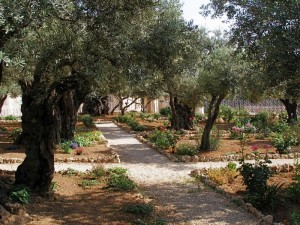 They have had their dinner during which, predicting his death, Jesus has instructed them to share bread and wine again and again in his memory. Jesus has washed their feet. He has given them his New Commandment, “Love one another.” Now, dinner ended, it is time for a stroll in the garden.
They have had their dinner during which, predicting his death, Jesus has instructed them to share bread and wine again and again in his memory. Jesus has washed their feet. He has given them his New Commandment, “Love one another.” Now, dinner ended, it is time for a stroll in the garden. It’s April! When did that happen?
It’s April! When did that happen?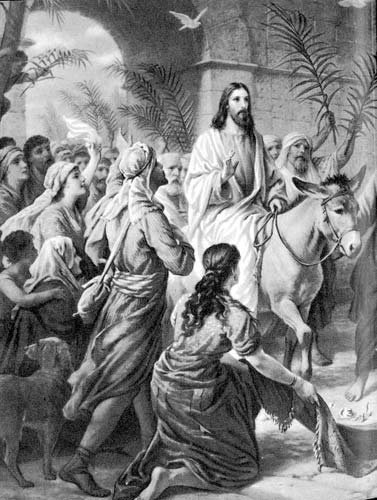 What is Jesus up to? Why is he doing this?
What is Jesus up to? Why is he doing this?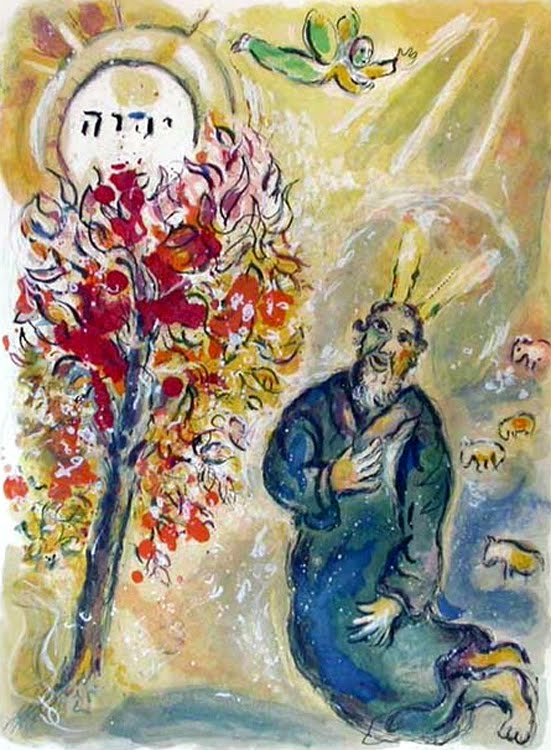
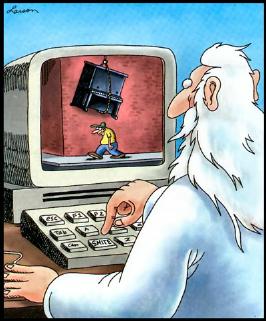 Some years ago the cartoonist Gary Larson published a cartoon of an old white-bearded judgmental God sitting at his computer terminal watching the live-streaming video of some feckless and unsuspecting sinner walk under a piano suspended from a crane while God’s finger is poised over a button on the keyboard labeled “Smite”. This seems to be the God these folk are describing to Jesus, a bookkeeper god who keeps a running tally of the good things and bad things we may do and then at some arbitrary point pushes the “Smite” button and puts paid to our cosmic account. This is the god of those who ask “Why me? What have I done to deserve this?” when something bad happens to them. This is the god of those who say “Everything happens for a reason” when something bad happens to someone else. This is the picture of God that Jesus rejects utterly and completely.
Some years ago the cartoonist Gary Larson published a cartoon of an old white-bearded judgmental God sitting at his computer terminal watching the live-streaming video of some feckless and unsuspecting sinner walk under a piano suspended from a crane while God’s finger is poised over a button on the keyboard labeled “Smite”. This seems to be the God these folk are describing to Jesus, a bookkeeper god who keeps a running tally of the good things and bad things we may do and then at some arbitrary point pushes the “Smite” button and puts paid to our cosmic account. This is the god of those who ask “Why me? What have I done to deserve this?” when something bad happens to them. This is the god of those who say “Everything happens for a reason” when something bad happens to someone else. This is the picture of God that Jesus rejects utterly and completely.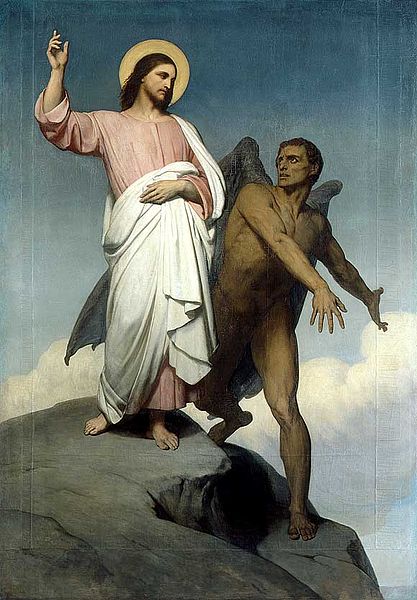
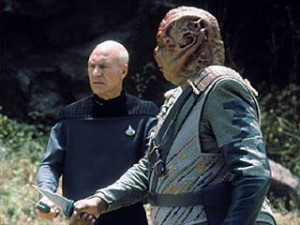 Darmok and Jalad at Tanagra!
Darmok and Jalad at Tanagra!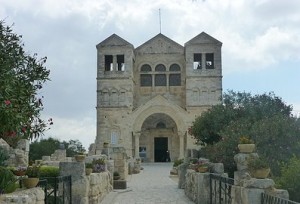 As many of you know, Evie and I were privileged to make a pilgrimage to the holy places of Palestine summer before last and one of the sites we visited was Mt. Tabor, the traditional “Holy Mountain” on which the Transfiguration is believed to have taken place.
As many of you know, Evie and I were privileged to make a pilgrimage to the holy places of Palestine summer before last and one of the sites we visited was Mt. Tabor, the traditional “Holy Mountain” on which the Transfiguration is believed to have taken place.

